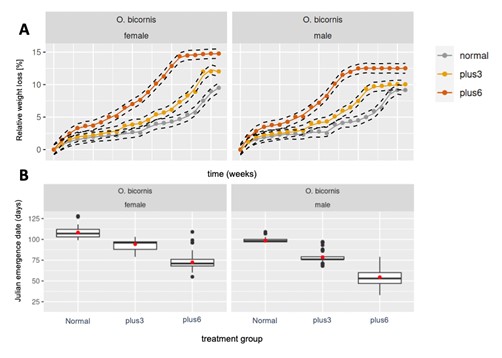Understanding how elevated temperature affect mason bee diapause: from molecules to populations.
Understanding how elevated temperature affect mason bee diapause: from molecules to populations.
- Background
Solitary bees provide essential ecosystem services through crop pollination, which has commercial benefits through the pollination of agricultural crops, as well as maintaining wildflower diversity, which has ecological benefits. Despite their benefits, these species are facing increasing environmental challenges, including habitat loss and fragmentation, disease, pesticides, as well as climate change, which are suggested to contribute to observed regional and global declines. In contrast to social bees, which are experiencing similar declines, solitary bees are predicted to lack the buffering capacity of social living placing them at increased risk. Climate change in particular is raising concerns over the ability of important pollinators to respond to environmental changes, which is predicted to affect species ranges (where they live) but also impact strategies, such as dormancy periods, that already help them survive periods of the year, such as winter, where the environment is more difficult to live in. Therefore, to address these shortcomings in our understanding, we are examining how elevated temperature during mason bee diapause influences changes in their condition and survival, and their capacity to respond to such changes. Furthermore, we aim to understand the molecular bases underlying thermal responses, as well as how they are evolving in natural populations.
- Methodology
To understand the ability of mason bees to maintain and survive diapause at elevated temperatures, we exposed both sexes of the red mason bee Osmia bicornis (Fig. 1) to three different fluctuating temperature regimes based on current and future predicted temperature profiles under scenarios developed by the Intergovernmental Panel on Climate Change (IPCC). The treatments consisted of a baseline temperature regime based on current data, as well as two elevated temperature regimes, whereby each temperature point was increased by three or six degrees, respectively. First, to understand how elevated temperature during diapause affected condition, we measured weight of each bee weekly throughout diapause. Second, to understand if elevated temperatures affected emergence from diapause, we performed daily emergence tracking for all bees. Lastly, to understand if elevated temperatures affected survival, we counted and compared the number of surviving individuals across each treatment.

Fig. 1. Understanding the effect of elevated temperature on mason bee diapause. For our study, we used the red mason bee Osmia bicornis, which (A) overwinter as adults in cocoons within nest cavities (Picture by Liv Lörchner). (B) Adults emerge in spring with males (smaller individual in the picture) emerging earlier than the females (larger individual) (Picture from WikiCommons).
- Initial findings
Our experiment began in December 2022 and was completed in June 2023 identifying three general patterns in relation to exposure of diapausing mason bees at elevated temperatures: 1) bees exposed to both elevated temperature regimes lost significantly more weight compared to the control bees (Fig. 2A); 2) bees emerged earlier with increasing temperature (Fig. 2B); and 3) while there was no significant difference in survival rates across exposure temperatures for females, we found lower survival rates in males at elevated temperatures suggestive that there may be susceptibility differences between the sexes in terms of how they respond to elevated temperature during diapause. Our findings support and expand upon previous literature on the effects of elevated temperature on solitary bee diapause by demonstrating the effects of fluctuating temperature regimes, taking into account daily and seasonal fluctuations, providing greater insight into the ability of mason bees to respond to current and predicted temperature increases.
- Ongoing work
As part of this project, we aim to link temperature-dependent responses in mason bees across multiple biological levels. From our temperature exposure trial, we have sampled mason bees during and after diapause across different treatment groups to investigate changes at the molecular level associated with elevated temperature exposure. In addition, to provide greater insight into the genetic health of these important ecological and commercial pollinators, we are performing a population genomics-based analysis of mason bees in Germany, which is currently underway.

Fig. 2. Elevated temperature during diapause increases mason bee weight loss and timing of emergence. (A) Males and females lose relatively more weight with increasing temperature exposure over time (grey = normal baseline temperature; yellow = plus 3 degrees above baseline temperature; red = plus 6 degrees above baseline temperature). Fitted lines from a generative additive model, including 95% confidence intervals are shown as dashed lines for each temperature treatment. (B) Both sexes emerge earlier in response to exposure at elevated temperature regimes.
This work was led by Jannik Möllmann, who was supervised by Dr. Joe Colgan at Johannes Gutenberg University Mainz. Additional funding support for the project was provided through a PhD scholarship from the Deutsche Bundesstiftung Umwelt (DBU). We greatly appreciate the Eva Crane Trust for their support in this project and thank them for their ongoing promotion of research into the conservation of bees.
Dr Joe Colgan,
Johannes Gutenberg University Mainz.


